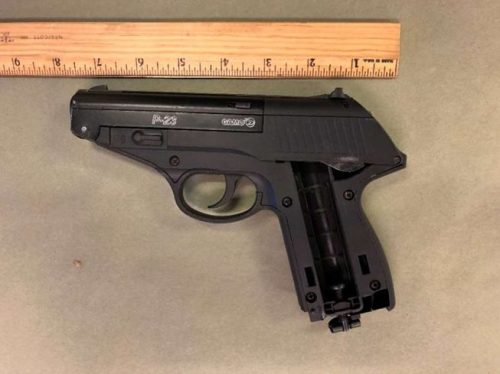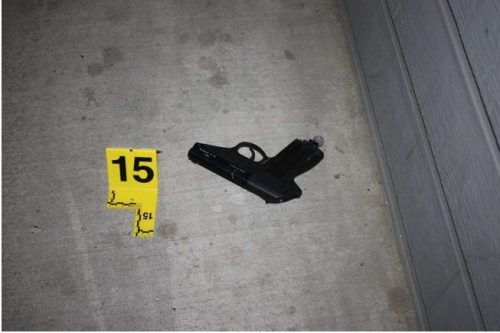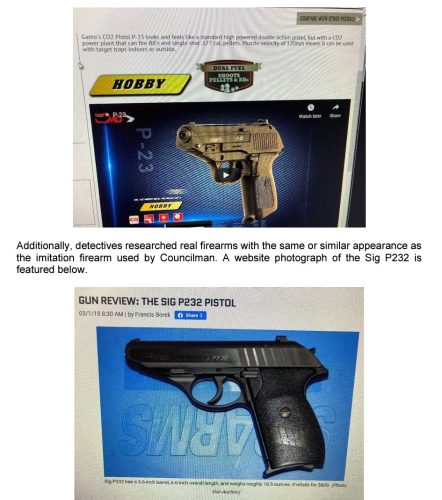Jamestown, CA — Tuolumne County District Attorney Cassandra Jenecke has completed an investigation into the May of 2020 officer-involved shooting death of 56-year-old Richard Councilman of Jamestown.
Councilman refused to leave the Preston Lane Apartments following a domestic violence incident and had threatened Tuolumne County Sheriff’s Office deputies. He was shot and killed after displaying what was later determined to be a replica firearm.
DA Jenecke reviewed the evidence related to the incident and points out that no charges will be filed against any of the law enforcement officers involved.
Jenecke’s 20 page letter, on the investigation details:
A law enforcement team had a tactical discussion, assessing the use of less-lethal options to handle Councilman. Deputy Daniel Newman needed 20 feet of space for his beanbag shotgun a photo of the breezeway:

A line on the breezeway marked a ten-foot distance from the apartment threshold. The team decided that if Councilman crossed this line, Deputy Oliver Imlach’s taser would replace Newman’s beanbag shotgun. Deputies waited for instructions from OIC Sergeant Cuellar and confirmed the absence of a phone inside the residence. Announcements began at 1:53 pm. Deputy Cody Stephens made multiple announcements before Councilman emerged with a 6-foot wooden staff in his right hand and a smaller stick on his belt.
In a confrontation with Councilman, deputies recognized the potential danger of the weapons he was carrying, including a 6-foot-long wooden staff. Multiple deputies ordered Councilman to drop his weapons.
Councilman did not comply and did not respond. This was noted in the dispatch log at 1:54 pm. At that time, Deputy Terry Knapp ordered “less-lethal up” and Deputy Newman pointed his less-lethal beanbag shotgun at Councilman and stated, “Put everything down. Put your hands up or I will shoot you with a less lethal shotgun. It will hurt.”
Deputy Newman shot Councilman with a less-lethal beanbag round in the right hip. Councilman’s body moved with the impact of the beanbag, but he remained standing, made no statements, and his facial expression did not change. After being hit with the beanbag round by Deputy Newman, Councilman reached into his right pants pocket, pulled out a firearm, and pointed the firearm in the direction of Deputies Cody Stephens and Newman. Multiple deputies ordered Councilman to drop the firearm.


 Deputy Newman did not discharge his lethal firearm. Deputy Stephens discharged his lethal firearm three times, striking Councilman three times. Deputy Knapp discharged his lethal AR15 five times, striking Councilman five times. Deputy Imlach took cover and did not discharge his lethal firearm. Deputy Eric Worthington did not discharge his lethal firearm.
Deputy Newman did not discharge his lethal firearm. Deputy Stephens discharged his lethal firearm three times, striking Councilman three times. Deputy Knapp discharged his lethal AR15 five times, striking Councilman five times. Deputy Imlach took cover and did not discharge his lethal firearm. Deputy Eric Worthington did not discharge his lethal firearm.
Sergeant Cuellar followed protocol by preserving the scene and assigning buddy partners to the involved deputies. The investigations were conducted by both the TCSO Investigations Unit and the Tuolumne County District Attorney’s Office Investigations Bureau, revealing that the firearm was, in fact, an imitation CO2 handgun.
Each deputy noted during their voluntary interviews that they knew Councilman had made threats of injuring law enforcement or engaging in “suicide by cop.” Moreover, each deputy stated that once (1) Councilman failed to respond to and comply with the deployment of a less-lethal weapon, (2) brandished his firearm, (3) pointed the firearm at deputies, and (4) failed to comply with orders to drop the firearm, they believed his intent was shoot one or more of the deputies present and they each felt the only way to stop Councilman from injuring them, their fellow deputies, or members of the public was to utilize lethal force.
The autopsy of Councilman found multiple gunshot wounds to the right hand, chest, back, buttock, and calves, and (2) external blunt injury to his right and left thigh. Moreover, forensic pathologist Dr. Michael Ferenc opined that Councilman was holding something in his right hand when he was shot by deputies on scene based on shot trajectory and the injuries that Councilman sustained. Toxicology results showed no measurable amount of alcohol or any controlled substances in Councilman’s blood at the time of his death.
Legal Analysis Overview
This review was conducted pursuant to the joint protocol between this Office and all Tuolumne County law enforcement agencies, which calls upon the District Attorney to conduct an independent assessment of the circumstances surrounding the use of deadly force. Possible criminal charges in this case against the involved deputies include murder (Penal Code section 187) or manslaughter (Penal Code section 192). To convict an officer of any of these charges, however, it would be necessary to prove beyond a reasonable doubt that no legal justification existed for the officer’s actions. (People v. Banks (1976) 67 Cal.App.3d 379, 383 – 384.) Several justifications may apply in any given case, and they are set forth in Penal Code sections 196, 197, and 853a. The justifications pertinent to this case are the use of force by law enforcement officers in self-defense and defense of others, which are found in Penal Code section 196 and 835a. A criminal complaint cannot be filed by the People unless the offenses alleged can be proved beyond a reasonable doubt. To convict any of the deputies involved in the shooting death of Richard Councilman on May 26, 2020, the People bear the burden of overcoming the presumption of innocence and proving the shooting was not in selfdefense, or defense of others, beyond a reasonable doubt. Consequently, the ultimate question in this case is the following: “Can the People disprove lawful self-defense, or defense of others, beyond a reasonable doubt?” Based on the law and evidence in this case, the answer is no.
See the full report for specific Applicable Laws
Finding: There Is Insufficient Evidence To Charge The Involved Deputies With Murder Or Manslaughter.
There is insufficient evidence to prove deputies did not have an honest and reasonable belief that Richard Councilman was going to shoot them.
To convict any of the deputies in the death of Councilman, the People would have to prove beyond a reasonable doubt that the involved deputies did not reasonably believe force was necessary to defend against an imminent threat of death or great bodily injury. In this case, there is insufficient evidence to carry that burden for five reasons.
First, there is evidence to support the deputies’ belief that Councilman had a proclivity for violence. All responding deputies knew of or were informed of the May 25 domestic violence incident. This information was included in the Watch Commander’s Report and several deputies had reviewed Deputy Worthington’s report prior to their arrival. In separate interviews, all deputies noted that they were aware that the basis for Councilman’s arrest was a domestic violence incident against CV the day prior.
Second, there is evidence to support the deputies’ belief that Councilman intended to use violence against responding deputies. Deputies were also aware of Councilman’s threats of physical violence towards law enforcement. CV informed responding deputies on May 25 that Councilman had made threats against law enforcement. This information was included in the Watch Commander’s Report.
Moreover, on May 26, 2020, CV informed Dispatcher Olson that Councilman “threatened to hurt you guys or to have you guys kill him.” CV told Dispatcher Olson that Councilman’s threats against law enforcement had been made that day, and reported that Councilman told her, “Yes, he said, ‘Call the police. I am ready to die,’ which means he is going to try and fight you guys.” CV reported that Councilman told her that he would not be going back to jail and that he would “try to hurt them [law enforcement]” if they tried to approach him. This information was conveyed over dispatch to responding deputies. In separate interviews, all deputies noted that they were aware of Councilman’s continued threats of violence against law enforcement.
Third, there is evidence to support the deputies’ belief that Councilman was potentially armed with weapons before he exited his apartment. Deputies received information on May 25 that Councilman was known to be armed with a knife or a martial arts weapon on his person based on information provided by CV. Additionally, during her 9-1-1 call on May 26, CV told Dispatcher Olson that Councilman was armed, but she did not know with what type of weapon and Councilman refused to tell her when she asked. Councilman told her, “It doesn’t matter.”
Fourth, there is evidence to support the deputies’ belief that Councilman was armed with potentially deadly weapons when he exited his apartment. Upon exiting his apartment, Councilman was observed by all deputies carrying a six-foot-long wooden staff. Moreover, he was observed to have a wooden sword sheathed on his belt. In separate interviews, each deputy noted that they perceived those weapons as ones that could be used to cause great bodily injury or death to them or others if used in a violent way by Councilman.
Fifth, there is evidence to support the deputies’ belief that Councilman intended to use lethal force on them when he brandished the imitation firearm at them. Councilman knew he was surrounded by deputies. He ignored loud and repeated warnings from multiple deputies to drop his weapons, put his hands up, and surrender. Instead, Councilman continued to stand armed with his staff and sword without speaking to deputies. Councilman was warned that he would be shot with a less-lethal beanbag round, and he did not change his behavior, stance, or offer any communication with deputies. He was shot by the less-lethal beanbag round and his only reaction was a slight movement of his body with the impact of the round. Then,
Councilman reached into a pocket on his person, pulled out what was later discovered to be an imitation firearm, and pointed the imitation firearm in the direction of Deputies Stephens and Newman. Councilman failed to comply with orders to drop the gun. Deputies Stephens and Knapp shot Councilman, who later succumbed to his injuries from that shooting. Pictures of the imitation firearm are included in the facts section above; however, it must be said that the resemblance of the imitation firearm to the Sig Sauer P232 is more than substantially similar. It is uncanny. Indeed, the P-23 imitation CO2 Pistol is marketed as “looks and feels life a standard high powered double action pistol.” Under Penal Code section 12550, an imitation firearm means “any BB device, toy gun, replica of a firearm, or other device that is so substantially similar in coloration and overall appearance to an existing firearm as to lead a reasonable person to perceive that the device is a firearm.” There was no evidence to suggest that the firearm Councilman pointed at Deputies Stephens and Newman was an imitation. Indeed, the similarity, coloration, and overall appearance of the imitation firearm would lead a reasonable person to perceive that the device was a firearm. All deputies on the breezeway perceived the imitation firearm as a real firearm at the time Councilman removed it from his pocket.
Deputies Stephens and Knapp needed to make a split-second, life-or-death decision based on the information available to them – that Councilman was a violent felon who had expressed his intent to harm or kill law enforcement multiple times that was armed with and pointing a real firearm at responding deputies.
When reviewing the totality of the circumstances here, it is also required that we review the pre-shoot tactical decisions of the deputies and determine whether those decisions and actions artificially and significantly increased the probability that unnecessary deadly force would be used.
In the present case, there is insufficient evidence to show that the pre-shoot tactical decisions of the deputies artificially and significantly increased the probability of deadly force. Indeed, the opposite is true. Deputies took a substantial amount of time making the area around the Councilman apartment safe including evacuating surrounding apartments. From the time of first arrival to the time of the making of announcements, approximately thirty-six minutes passed. During that time, deputies on the breezeway had tactical conversations about who would handle the less-lethal and lethal force options, which less-lethal force options would be used when, and where Based on the totality of circumstances, there is insufficient evidence to prove Deputies Stephens and Knapp did not have an honest and reasonable belief that Councilman was going to shoot them or their fellow deputies.
There is insufficient evidence to prove the immediate use of force was not necessary to defend against the perceived danger that Councilman posed to the deputies.
There were no less-lethal options for Deputies Stephens and Knapp to defend themselves and their fellow officers from their perceived threat of being shot by Councilman, making the firing of their weapons reasonably necessary. Councilman had failed to comply with all lawful orders, which resulted in the deployment of a less-lethal beanbag shot. Councilman’s failure to comply continued and he escalated the situation by pulling out an imitation firearm and pointing it at deputies. Less-lethal force like a beanbag gun or taser would have been ineffective against what they perceived as the threat of being shot by a firearm. Under the circumstances of this case, the use of firearms was reasonable, necessary, and proportional to any imminent threat the deputies may have perceived.
Additionally, any claims that the deputies could have retreated or reached a place of safety instead of shooting does not affect the conclusion of this report for two reasons. First, those who act in self-defense may stand their ground and are not required to retreat. (CALCRIM 505.) Moreover, the potential for the deputies to safely retreat is not supported by the evidence. The space in which this encounter occurred was relatively small and surrounded by apartments with, at the most, minimal of cover. Moreover, deputies would have had to flee down a flight of stairs to retreat from Councilman. Consequently, there is insufficient evidence to prove beyond a reasonable doubt that the officers did not reasonably believe the use of force was necessary.
There is insufficient evidence to prove the deputies used more force than reasonably necessary.
Councilman ignored repeated commands to drop his weapons, put his hands up, and surrender while facing uniformed police armed with handguns, tasers, and tactical rifles. Based on the circumstances, there could not have been any question in his mind that the police were there to arrest him and that they might use lethal force if he threatened them. Moreover, Councilman was present during the making of CV’s 9-1-1 call and was aware that law enforcement would be responding to the scene.
Despite this knowledge, Councilman failed to comply with the deputies’ orders and was shot by the less-lethal beanbag shotgun round. He had little to no reaction except to then pull out an imitation firearm from his pocket and point it at the deputies. Of note, Councilman would have needed to come closer to the deputies (within ten feet) while armed with what deputies perceived to be loaded and operable firearm to use Deputy Imlach’s taser. At this point, Councilman had elevated the encounter to such an extent that available less-lethal options (a taser and additional beanbag rounds) were not feasible to eliminate the imminent threat of great bodily injury or death.
Councilman failed to comply with deputies’ orders to drop his gun and he was shot. Deputies Stephens and Knapp both demonstrated restraint when using their lethal weapons. Deputy Stephens fired only three of the twenty-one available rounds in his handgun while Deputy Knapp fired only five of the thirty available rounds in his rifle. Both noted in their interviews that they ceased firing when they believed Councilman no longer posed a threat.
Consequently, there is insufficient evidence to prove the deputies used more force than reasonably necessary.
Compliance with agencies policies as a factor in the totality of the circumstances in determining whether deputies acted reasonably.
Use of force by deputies employed by the Tuolumne County Sheriff’s Office is governed by Policy 300 – Use of Force in the Tuolumne County Sheriff’s Office Policy Manual.2 Policy 300.4 and Penal Code section 835a note that where feasible, deputies shall make reasonable efforts to identify themselves as peace officers and warn that deadly force may be used, unless the deputy has objectively reasonable grounds to believe the person is aware of those facts.
In the present case, there is no evidence that Deputies Stephens and Knapp warned Councilman that they would use deadly force. However, there were objectively reasonable grounds to believe Councilman was aware of those facts. Deputies had identified themselves through announcements, a less-lethal weapon had already been deployed with no change in circumstance, and three other deputies were armed with weapons pointing at Councilman. Based on the circumstances, there could not have been any question in Councilman’s mind that the police were there to arrest him and that they might use lethal force if he threatened them. Consequently, the failure of Deputies Stephens and Knapp to warn Councilman that they would use deadly force would not change the conclusion of this report.
A review of the other portions of Policy 300 did not reveal any other questions related to agency policy compliance. Policy 300 mirrors and is consistent with the law as it stands today. As such, it appears likely that a trier of fact (such as a jury in a criminal trial charging the involved officers with a crime), would find the operation to apprehend Councilman was consistent with Tuolumne County Sheriff’s Office policies, mission, Penal Code section 835a, and Government code section 7268.
Based on the above information and analysis, the compliance of Deputies Stephens and Knapp with their agency’s policies does not affect the evidence to establish the legal elements of self-defense.
Conclusion
The deputies of the Tuolumne County Sheriff’s Office, including those involved in this case, are dedicated public servants who work tirelessly to protect the public and regularly put their lives in harm’s way to do so.
Deputies assigned to the apprehension of Richard Councilman faced a particularly difficult task. They knew he was a suspect in felony domestic violence case, they knew him to be regularly armed with a knife or some type of martial arts weapon, and they reasonably believed he would fight or gravely injure law enforcement officers to avoid being apprehended. We know that domestic violence calls and threats of suicide by cop are some of the most dangerous for our law enforcement community. Indeed, a 2016 study found that 14% of fatalities resulting from the use of lethal force by on-duty law enforcement officers from 2009 to 2012 in 17 states involved intimate partner violence and 18% were suspected “suicide by cop” incidents.
Our investigation has determined that Richard Martin Councilman Jr. was fatally shot by Tuolumne County Sheriff’s Office Deputies Stephens and Knapp during the attempted apprehension of Councilman for felony domestic violence. Councilman exited his apartment armed with weapons, was noncompliant with less-lethal force efforts, and then brandished what deputies perceived as a real firearm and pointed it at the officers. He remained noncompliant to orders to drop his firearm and continued to point the firearm directly at deputies in a threatening manner. It was at this point that lethal force was used to end the imminent threat of great bodily injury or death to the deputies.
Under the totality of the circumstances known to Deputies Stephens and Knapp at that time of the shooting, the only reasonable interpretation of the evidence supports that the use of self-defense by Deputies Stephens and Knapp was lawful.
Their conduct under any interpretation of the law does not rise to the level of criminal conduct that warrants the filing of criminal charges. We now consider this matter closed.
You can read Jenecke’s 20 page letter, detailing the investigation, by clicking here.

